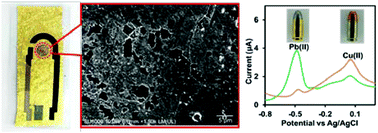Gold leaf electrochemical sensors: applications and nanostructure modification†
Abstract
This work presents the first planar three-electrode electrochemical sensor comprising local gold leaf as the working electrode and printed, or hand-drawn, counter and reference electrodes, respectively. The gold leaf was mounted on a polyvinyl chloride (PVC) adhesive sheet (15 mm × 30 mm) and covered with a second PVC sheet printed with the counter and reference electrodes. This sheet has a 3 mm circle and a 2 mm × 3 mm rectangle removed to expose the gold electrode area and electrical contacts, respectively. A third shorter insulating layer with a 10 mm circular hole was placed on top to delineate the sensing area of all electrodes. The sensor displayed expected performances in various modes of operation, such as cyclic voltammetry, square wave voltammetry and anodic stripping voltammetry. For the latter mode, the limit of detection of Pb(II) was 3.2 μg L−1, compliant with regulation for drinking water (10 μg L−1 Pb(II)). Although designed as a disposable unit, the electrode is effective for up to 200 cycles and applicable for multiple use. The gold leaf was modified by electrodeposition of the gold network and large nano-size gold particles which significantly enhanced the sensitivity of all voltametric sensing, giving lower limits of detection. For stripping voltammetry, the electroplating structure modification improved the simultaneous detection of lead and copper, with the copper response increasing 6-fold. The device has the capability of on-site identification of copper/lead bullets from gunshot residues within 6 min.



 Please wait while we load your content...
Please wait while we load your content...